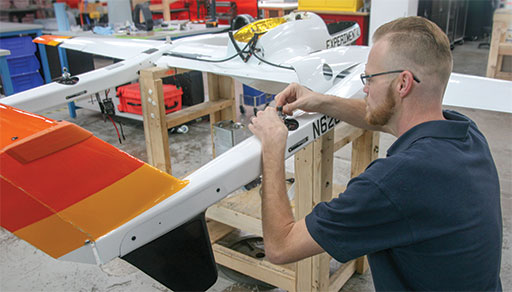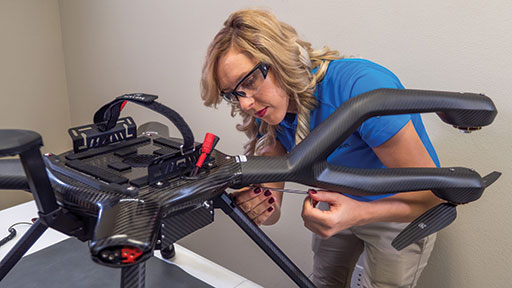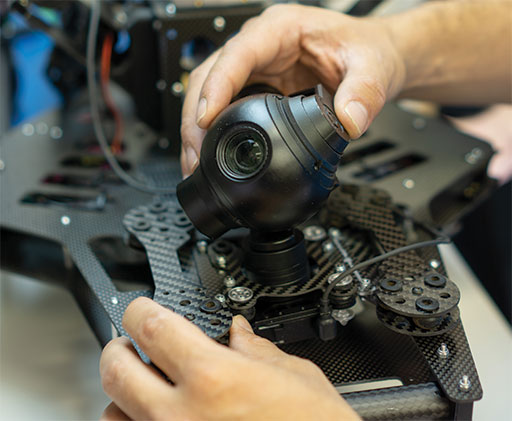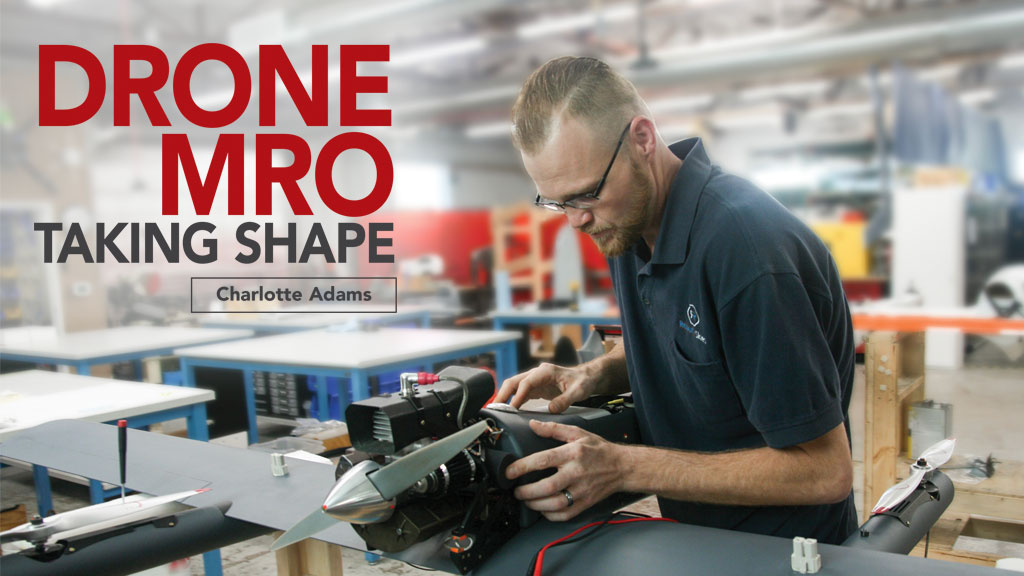Although air taxis in the U.S. are still at least a few years off, small commercial drones – remotely controlled unmanned aircraft – have a strong foothold and their repair and maintenance infrastructure is already taking shape. Driving their growth is their versatility – they are entering applications such as cargo delivery, surveillance, agriculture, oil and gas, public safety, construction, insurance, mapping, and logistics.
The FAA has engaged with the unmanned aircraft system (UAS) industry and has given many operators provisional approvals to fly vehicles. As of February 2020, the agency had registered 436,836 commercial drones. Technavio predicts the commercial drone market will reach $20.4 billion by 2024. According to ResearchAndMarkets.com, the drone package delivery sector, alone, is expected to hit $2.1 billion in value by 2023.

All images courtesy of Robotic Skies.
As volume expands, drone manufacturers, distributors, traditional maintenance shops, and insurance companies are focusing on the aftermarket. In this nascent industry, however, drone manufacturers are the heavy hitters, as they control the intellectual property and the supply of components necessary for repair and maintenance.
Drone Insurer’s Perspective
The plug-and-replace model seems to hold for small UAS batteries. These components are not really fixable currently, says James Van Meter, regional head of aviation programs and product development in North America for Allianz’s Global Corporate & Specialty unit. Allianz pioneered commercial drone insurance back in 2012.
The company insures thousands of commercial drones – most of them operated under FAA Part 107 — and has settled hundreds of claims relating to them, he says. The majority of these claims have concerned physical damage to the drone, itself.
Allianz does not want its insureds to ship batteries that may have been damaged and the manufacturers don’t want to receive them, Van Meter says. It instructs its insureds to dispose of these components in the appropriate manner. Typically the insurance company would send the insured a claim check and the insured would purchase a replacement battery, he says.
Sometimes drones are repairable, especially high-end air vehicles worth $40,000 or more, Van Meter says. “But the majority of our claims are total losses” because the value of the drone is so low that it doesn’t make sense to repair it. Some of Allianz’s insurance buyers operate drones in the $3,000-$4,000 range, so that repair costs could exceed the value of the drone. Unlike automobiles, drones have no “blue book” value and can depreciate quickly. Allianz relies on a combination of independent third-party shops and its relationships with drone manufacturers. Most of these shops are not Part 145-certified, as this is not required of Part 107 UAS, he says.
Robotic Skies, a network of more than 190 independently owned and operated Part 145 repair stations worldwide that work on UAS as well as traditional aircraft, boasts strong relationships with high-end UAS manufacturers like the Australian company, Carbonix.

Carbonix says its customers need professional service, low downtime, and exceptional record-keeping from maintenance suppliers. The company says that while it can service local customers, it partnered with Robotic Skies in order for its international customers to have “localized access to expert aviation maintenance, inspection, repair, and upgrade services” and “customized maintenance solutions anywhere in the world.”
At the other end of the spectrum, Drone Nerds, a retailer and wholesaler of commercial and recreational vehicles, boasts aftermarket services such as inspection, repairs, and test flights. Drone Nerds is also a distributor and authorized service center for Chinese drone giant, DJI.
“There will certainly be OEMs that use their own organic depot for warrantied maintenance services, but there will also be operators who will want to stand up their own internal MROs or alternatively use a network of third-party MROs that already service manned aviation today,” says Brian Schettler, senior managing director of Boeing HorizonX Ventures, Boeing’s venture capital arm. Like manned aviation, UAS aviation will have many certified subsystems such as avionics, batteries, and motors. These subsystems will have their own maintenance workflows and like manned aviation, specialty MROs will exist that do nothing but service these very specific subsystems, he predicts.

Boeing HorizonX Ventures led a funding round announced last year supporting Robotic Skies. This “complements Boeing Global Services’ commitment to growing the business aviation and general aviation market segment and demonstrates our continued commitment to creating the infrastructure and lifecycle support for safe autonomous aerial vehicles,” Schettler says. “From a services perspective, we are excited to help our customers explore how best to incorporate aftermarket support for their UAS operations up front, so that we can deliver holistic value from day one of operations.” Boeing is also an active participant in the urban air mobility market (UAM) through its NeXt unit.
Regulatory Landscape
The regulatory system in which drones and air taxis will be operated and maintained is not yet fully defined. Most small (under 55-pound) commercial drones are operated under FAA Part 107, which covers matters such as registration and airmen certification. But the standard currently does not address type certification or continuing airworthiness. The remote pilot in command is responsible for assessing whether the system is in a condition safe for operation. At the same time Part 107 imposes significant operational restrictions. Small commercial drones cannot fly over people, beyond line of sight (BLOS), above 400 feet, or near airports without permission.
But more complex operations — advanced by companies like Google Wing and UPS Flight Forward — will provisionally operate under Part 135 with various waivers to Part 107 requirements. It’s complicated, however. Whether or not an operator in FAA’s Integration Pilot Program falls under Part 107, 135, or 91 depends on individual FAA approvals.
“The real market potential lies in UAS built for complex operations beyond the limitations of Part 107,” says Robotic Skies’ president and CEO Brad Hayden. Larger autonomous vehicles, operating beyond-visual-line-of-sight and over people in complex operations, will have regulatory maintenance requirements similar to manned aircraft, he predicts. “Robotic Skies has the aviation experience and infrastructure to support customers who fly under Part 107 or any future regulatory framework,” he says.
In the near term, at least, large cargo drones and air taxis probably will be type-certified under FAA Part 23 and maintained under Part 43, says Erin Rivera, an attorney with Fox Rothschild LLP. The certification process will include the development of maintenance procedures, he says. In addition UAM and cargo drone operations probably will come under Part 135, which includes maintenance requirements, he says.
But, as data collection continues on these new designs, certification standards, and airworthiness criteria, the FAA will most likely — via rulemaking — create a new certification standard just for unmanned aircraft, Hayden predicts. “Thus far, we have not seen any relief from Part 43 requirements, or any maintenance requirements, outside of some parts traceability and record keeping provisions,” he says.
What Will MRO Look Like?
“My theory is that there’s going to be less of a requirement for maintenance compared with typical aircraft because there’ll be more plug and replace,” Rivera says.
Robotic Skies, on the other hand, targets the repair side of the “repair versus replace” equation. High-end systems that can carry heavier payloads are a significant investment, Hayden says. For the safety and ongoing reliability of that investment, formal maintenance programs play a key role. Examples of specialized payloads are LIDAR (pulsed laser) sensors and “Hollywood-grade” cameras, he says.
These vehicles already require scheduled maintenance, Hayden says. “A company isn’t going to spend $80,000 to $100,000 on an aircraft with a short life span.” And it’s not just the aircraft, it’s the whole system, including takeoff-and-capture mechanisms, command-and-control technology, and payload handling. Operators are going to want a continued airworthiness program to extend the life of the assets, he says.
Robotic Skies provides business development services for the new market by identifying UAS operators who need maintenance or repair services and connecting them with the nearest repair station. The company’s software platform, meanwhile, schedules, tracks, and invoices the work.
Many manufacturers have some form of post-sale customer support and understand its importance, but it is a challenge for them to scale that support, Hayden says. It may not be feasible or economical for customers to ship a system back to the factory or the manufacturer may not have the in-house staff to support the volume as its business grows.
“I saw an opportunity for a company to provide turnkey field maintenance services for unmanned aircraft systems that would also give manufacturers and operators a leg up on regulatory compliance,” Hayden says. Robotic Skies provides a way to serve this emerging market using existing channels.
Air Taxis
Air taxis – designed to transport people – will be bigger than today’s 55-pound commercial drones. One question is battery care. Airbus’s Vahana vehicle project, for example, employed two 300-pound lithium ion batteries.
“Initially these things are not going to be repaired – they will be replaced,” Rivera says. They are essentially “big batteries … with a little aircraft around them.” After 1,000 to 2,000 cycles, what’s the value of that aircraft? “We’re going to go away from aircraft that last 30 to 40 years.” And they probably will have fewer overhaul cycles than aircraft today, he adds. Field inspections will be required and maybe some checking and light servicing.
They might be able to take the airframe down to the nuts and bolts, Rivera says, but as battery technology rapidly improves in energy density per size and weight — and if the battery system is 60 percent of aircraft weight — it might make sense to replace the entire vehicle.
These aircraft will be subject to a lot of wear and tear, not based on the number of hours flown, but on the number of takeoff and landing cycles, he says. “Cycles are probably going to be the limitations for parts,” Rivera predicts.
Traditional components such as propellers and gas turbines will follow standard maintenance practices, but a lot of the new electric propulsion systems “will be sent right back to the manufacturers, and they will decide whether to overhaul them internally or scrap and recycle them,” Rivera says. It really depends on cost. Eventually, however, as the industry gathers steam, people from the parts manufacturers will set up repair shops and more will be done in the field, he predicts.
Hayden concedes that some OEMs, for various reasons, might want to keep some maintenance activities in house. Servicing batteries in the field, for example, can be difficult, as it is a new technology. So battery maintenance will depend on how the OEMs want to handle it. Also, more complex vehicles like air taxis may involve a higher level of integration, which means that their maintenance programs, at least initially, may be more challenging and expensive than they would be for better understood and less integrated technologies.
Air taxis will require a more complex support infrastructure. Lithium ion batteries, for example, sometimes experience “thermal runaway,” a condition in which they vent flaming gases. If this happens on a rooftop vertiport, what do you do, asks Rex Alexander, president of Five-Alpha LLC and urban air mobility infrastructure guru. “Do you want to run the risk of having it reignite in an elevator on the way down?” You need a place on the roof to quarantine that vehicle, he says.
“You can do a lot of repairs on a rooftop,” Alexander says. But a lot depends on how much access you have to the elevators to get parts like an entire engine down. And if you’re swapping out batteries at a vertiport, you need a place to store the batteries.
Training
Another tall pole in the tent is technician training. A&Ps, for example, study electrical systems and wiring, but not electric motors, Alexander says. And the battery training piece will be huge, he adds.
The A&P curriculum does not cover electric engines, agrees Terry Palmer, president of Pilot Landing LLC, an aviation consulting firm with a focus on maintenance training. That will be an issue, she predicts. “If you look at electric cars,” for example, getting them maintained reliably is a “huge problem.” A good thing about UAS, she says, is that they can start the safety culture from the beginning.
Robotic Skies has identified training as part of its overall process. It manages the MRO process end-to-end by working with UAS manufacturers to formalize maintenance programs, document inspection, and repair training, Hayden says. The company then deploys and manages the program in the field and provides specialized OEM-certified training to the repair station technicians.
UAS training is unique because it is not just the airframe and powerplant, it is a whole system that can include launch-and-recovery systems, command-and-control technology, and payload handling, he says.
Hayden also heads an ASTM subcommittee looking at the issue of unmanned aircraft technician training. The group is looking at existing ASTM standards to identify gaps between them and what will be needed in the field.
Hayden believes that current technicians – particularly avionics repairmen — will require specific training to address the peculiarities of these unmanned systems, but that their skills and knowledge are highly applicable to UAS. In addition, he foresees a blurring of roles between avionics repairmen, A&Ps, and even ground handlers in the drone/air taxi world. As automation kicks in, for example, who’s going to do the preflight walkaround? Those people may potentially have their own rating and have to be certified.
Avionics systems for air taxis will get much more complicated, especially as they shift to pilotless operations, Alexander says. The parts that people are going to be concerned with are communications, software systems, fly-by-wire control, and electrical systems, Rivera adds. There will be a lot of on-the-job training, he predicts.
